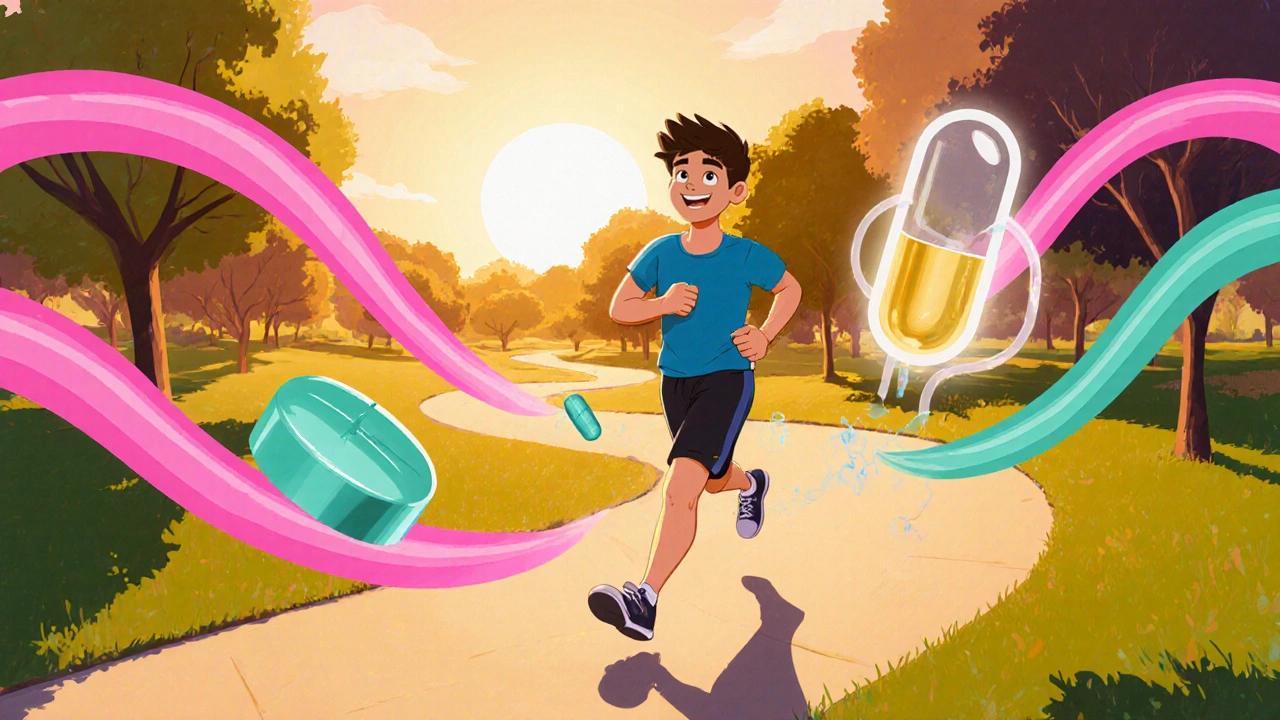When treating depression, Desvenlafaxine is a serotonin‑norepinephrine reuptake inhibitor (SNRI) that raises the levels of key mood chemicals in the brain. Pair it with regular Exercise refers to planned, structured physical activity that improves fitness and health, and you have a combo that hits depression from both the chemistry and lifestyle angles.
Why the Pair Works
Depression isn’t just a “feeling”; it’s a mess of neurotransmitters, brain‑derived neurotrophic factor (BDNF), and stress hormones. Desvenlafaxine boosts serotonin and norepinephrine, while exercise spikes dopamine and releases endorphins. The two together create a neurochemical surge that can be stronger than the sum of its parts.
- Serotonin boost: Both raise serotonin, improving mood stability.
- Norepinephrine lift: Exercise stimulates norepinephrine release, sharpening focus and energy.
- BDNF increase: Physical activity spikes BDNF, which supports new neuron growth, a benefit that medication alone can’t provide.
Clinical trials from 2023‑2024 show patients on desvenlafaxine who added 150 minutes of moderate‑intensity aerobic exercise saw a 30% faster reduction in Hamilton Depression Rating Scale (HAM‑D) scores than those who relied on medication alone.
How Desvenlafaxine Works
Desvenlafaxine blocks the reuptake of serotonin and norepinephrine, letting more of these chemicals stay in the synaptic cleft. This action lifts mood, eases anxiety, and can improve sleep quality. It’s taken once daily, usually 50 mg, and reaches steady‑state levels after about a week.
Key attributes:
- Half‑life: Approximately 11 hours, allowing flexible dosing.
- Metabolism: Primarily via CYP3A4; fewer drug‑drug interactions than older SNRIs.
- Side‑effect profile: Common issues include nausea, dry mouth, and increased blood pressure.
Exercise Types That Complement Desvenlafaxine
Not all movement is equal for mood. Research points to two categories that shine when combined with antidepressants:
- Aerobic exercise - jogging, brisk walking, cycling, or swimming for 30‑45 minutes, 3‑5 times per week. This raises heart rate, which in turn spikes dopamine and endorphins.
- Resistance training - weight‑lifting or body‑weight circuits 2‑3 times weekly. Strength work lifts self‑esteem and improves sleep, both critical for depression recovery.
If you’re new to fitness, start with low‑impact options like walking or water aerobics and gradually increase intensity.

Putting It All Together: A Practical 8‑Week Plan
Below is a week‑by‑week schedule that blends medication adherence with progressive exercise.
| Week | Medication | Exercise (minutes/week) | Key Focus |
|---|---|---|---|
| 1‑2 | 50 mg desvenlafaxine once daily | 90 (30 min walking x3) | Establish routine, monitor side‑effects |
| 3‑4 | 50 mg desvenlafaxine | 150 (45 min cycling x3) | Increase aerobic intensity, add light stretching |
| 5‑6 | 50 mg desvenlafaxine | 180 (30 min run + 30 min resistance x3) | Introduce resistance training, track mood scores |
| 7‑8 | 50 mg desvenlafaxine (evaluate need for dosage tweak) | 210 (45 min interval run + 30 min resistance x3) | Peak intensity, prepare for maintenance phase |
Throughout, keep a simple mood journal. Note energy levels, sleep quality, and any new side‑effects. If blood pressure spikes (above 140/90), talk to your prescriber.
Potential Pitfalls and How to Avoid Them
- Over‑exertion: Pushing too hard can raise cortisol, which may worsen anxiety. Stick to the progressive plan.
- Medication timing: Take desvenlafaxine with food to reduce nausea. Avoid exercising immediately after a dose if you feel dizzy.
- Side‑effect monitoring: Elevated blood pressure is the most serious risk. Check it weekly, especially during high‑intensity weeks.
- Adherence: Missing exercise sessions can undo gains. Set reminders, pair workouts with a favorite podcast, or find a buddy.

Comparing Desvenlafaxine + Exercise to Other Approaches
How does this combo stack up against just meds or other antidepressants? The table below looks at three common scenarios after eight weeks of treatment.
| Approach | Average HAM‑D Reduction | Side‑Effect Burden | Exercise Interaction |
|---|---|---|---|
| Desvenlafaxine + Exercise | -12 points | Moderate (nausea, BP rise) | Synergistic; improves adherence |
| Desvenlafaxine alone | -8 points | Moderate | Neutral |
| Sertraline + Exercise | -10 points | Low (sexual dysfunction common) | Positive; but serotonin‑only focus |
While sertraline has fewer cardiovascular concerns, it lacks the norepinephrine boost that helps with low energy. Desvenlafaxine’s dual action pairs especially well with the catecholamine surge from aerobic work.
Frequently Asked Questions
Can I start exercising before my first dose of desvenlafaxine?
Yes. Beginning a low‑intensity routine (like 20‑minute walks) can set a positive tone and make later sessions feel easier. Just avoid very intense workouts in the first few days until you know how the medication affects you.
Do I need a doctor’s approval to combine desvenlafaxine with exercise?
It’s wise to discuss any new physical regimen with your prescriber, especially if you have heart or blood‑pressure issues. Most clinicians encourage at least moderate activity as part of depression care.
What if I feel more anxious after a workout?
A brief spike in anxiety can happen as cortisol rises during intense effort. Cool‑down stretches, deep‑breathing, and keeping workouts at a manageable intensity usually calm the response. If anxiety persists, trim session length or switch to gentler activities like yoga.
Should I take desvenlafaxine with food?
Taking it with a meal reduces stomach upset, the most common side‑effect. It doesn’t affect absorption dramatically, so consistency is the key factor.
Is resistance training safe while on desvenlafaxine?
Yes, as long as you monitor blood pressure and avoid holding your breath during heavy lifts (the Valsalva maneuver), which can artificially spike BP.
Next Steps If You’re Ready to Try This Combo
1. Schedule a brief chat with your psychiatrist or primary‑care provider. Mention your interest in adding structured exercise.
2. Get a simple home‑based fitness plan or join a beginner class. Many community centers offer free or low‑cost aerobic sessions.
3. Set up a tracking sheet-date, medication dose, exercise type, minutes, mood rating (1‑10). Review it after each week.
4. Check blood pressure after the first two high‑intensity weeks. If it stays under 140/90, you’re good to continue.
5. Re‑evaluate with your doctor at the 8‑week mark. If you’ve shaved 10+ points off the HAM‑D or feel noticeably brighter, you’ve likely found a winning pairing.
Combining desvenlafaxine with regular exercise isn’t a magic bullet, but it’s a solid, evidence‑backed strategy that tackles depression on two fronts: chemistry and lifestyle. Give it a shot, stay consistent, and let both your brain and body do the heavy lifting together.


10 Comments
Octavia Clahar
What really matters is that you don’t just pop a pill and hope for miracles, you have to move your body too. Desvenlafaxine gives you a chemical push, but without the exercise boost you’re missing the BDNF wave that actually builds new connections. I’ve seen people treat the meds like a magic wand and then complain when they’re still stuck. Pairing it with a structured cardio routine forces the brain to adapt, and that’s where real change happens. Keep the dose steady, watch your blood pressure, and make sure you’re not skipping those three weekly sessions. If you can stay consistent for eight weeks you’ll actually see the numbers drop, not just feel a fleeting lift.
eko lennon
So let me paint the picture for you, dear reader, as if we were in a grand theater of the mind where every neuron is a spotlight and every heartbeat a drumroll that sets the tempo of our very existence. You start with desvenlafaxine, that humble chemical messenger boy, sneaking into the synapse to keep serotonin and norepinephrine from fleeing the party like timid wallflowers. Then you stride onto the stage of the gym, the treadmill humming like a restless engine, the dumbbells clanking with the promise of iron-clad confidence. The first week feels like a gentle overture, a soft piano melody as you walk for thirty minutes, feeling the subtle rise of dopamine whispering in your ears. By week three the plot thickens; you crank up the intensity, cycling and feeling the wind in your hair, your heart pounding like a bassline that makes the entire audience sit up straight. Each session is a scene change, a crescendo that pushes cortisol to the edge but also flings BDNF into the limelight, where it starts rewiring the set with fresh scripts. The medication and the sweat collaborate like a dual protagonist, each feeding the other’s momentum, creating a synergy that feels almost cinematic. By the time you hit week five, you’re not just lifting weights, you’re lifting the veil of gloom that once hung over your daily script. The narrative arc reaches its climax in weeks seven and eight, when interval runs and resistance training fuse into a spectacular finale, leaving the audience – that’s you – breathless and exhilarated. The ending? Not a neat bow tie, but a promise of continuation, a sequel where you keep the routine alive and the medication as your steadfast sidekick. In short, this is not just a treatment plan; it’s an epic saga where every rep, every dose, writes a line of hope onto the page of your life.
Sunita Basnet
Integrative neuropharmacology synergizes with aerobic conditioning to amplify neurotrophic signaling pathways BDNF upregulation occurs concomitantly with serotonergic reuptake inhibition resulting in enhanced synaptic plasticity outcomes are quantifiable via HAM‑D decrements the protocol leverages periodized load progression minimizing cortisol spikes operationalizing adherence through habit stacking yields sustainable behavioral change.
Melody Barton
Listen, you’ve got the meds and the plan, now just get off the couch and move. Simple steps – walk, jog, lift – keep it steady and you’ll see the mood lift. No excuses, just action.
Justin Scherer
Good overview of how the two treatments can work together. The table makes it easy to compare outcomes and the side‑effect notes are helpful for anyone thinking about starting this combo.
Pamela Clark
Oh wow, another “groundbreaking” combo that supposedly fixes everything – because clearly taking a pill and jogging is the cure for all of life’s complexities. Sure, why not add a sprinkle of sarcasm while we’re at it?
Diane Holding
The plan looks doable.
Cheyanne Moxley
Honestly, if you’re not taking this seriously you’re just being lazy with your mental health. It’s not a game; you either commit or you stay stuck.
Kevin Stratton
Life is a series of choices, each echoing into the next. When you combine a molecule that steadies the mind with movement that awakens the body, you’re essentially aligning two opposing forces into harmony. Think of it as a philosophical dance – the medication sets the rhythm, exercise writes the steps. Together they compose a symphony of wellbeing. 😊
Manish Verma
Look, as an Aussie I can tell you that this plan sounds solid, but you’ve gotta remember that discipline is what makes a nation strong. If you can’t stick to a schedule, you’re just feeding the lazy mindset that weakens our community.